WALKING TOUR 1: HIGHLIGHTS OF BERLIN
In this first walking tour, you will discover the diverse aspects of the city. The tour starts at the heart of former East Berlin and crosses the Spree on the important Museuminsel (Museum Island). After that, we walk to the well-known Gendarmenmarkt and pass Checkpoint Charlie. Of course, the new Potsdamer Platz can’t be left out. Afterwards we’ll pass through the Kulturforum with countless museums and walk towards the Memorial for the Murdered Jews of Europe. We end our walking tour near the Brandenburger Tor with the Reichstag and Unter den Linden. If you want to stop and visit all the sights you pass during the tour, it is better to split it up over the course of two days.
Distance: 9 km

Starting point: U-Bahn (subway) Alexanderplatz
Finishing point: U-Bahn (subway) Friedrichstraße
Accessible for wheelchairs. The walking tour runs over paved roads.
No signage. Use the map in this publication.
= directions = sight A 1
We start our tour at the Alexanderplatz subway station Walk in the direction of the high television tower, the Fernsehturm. Behind it lies the Neptune Fountain You will also be able to see Berlin’s city hall, the Rotes Rathaus (“Red cityhall”).
Right from the beginning, the Alexanderplatz named after Tsar Alexander I who visited Berlin in 1805, was a place full of commercial activity, with shops and a market hall. A lot of it was destroyed during World War II. After the war, the place fell into the hands of the Soviets, something the stern social democratic architecture bears witness to. The square is a busy traffic junction and is dominated by the 368-metre-high television tower, also called the Fernsehturm (1969), the highest building in all of Germany. Inside the huge sphere, which is a reference to the Sputnik satellite, there is a restaurant that turns around its axis and provides you with a magnificent view of the city. The Marienkirche, in early gothic style, can also be found in the square. More striking is the Rote Rathaus from the 19th century, with a tower that is almost 100 metres high. You can also have a look at the world clock, which shows the time in various places around the world.
Just before the Rotes Rathaus, walk into the Jüdenstraße and cross the busy Grünerstraße. That way, you will arrive at the city’s old city hall.
© www.travual.com // Buy the complete guide on shop.themediabay.be/en 4
1
A
The old city hall (Altes Stadthaus), originally called new city hall (Neues Stadhaus), was first put into use in 1911 when the Rotes Rathaus became too small. The building was damaged in the bombings of World War II and was renovated by the DDR after the war. Until 1955, East Berlin’s administration was established here. The GDR’s council of ministers used it afterwards.
Since the German reunification, it is used by the ministry of Labour and Social Affairs.

At the old city hall, take a right and walk through the Spandauerstraße. You will see the Nikolaikirche on your left side Depending on the number of churches you wish to visit on this tour, it is worthwhile to step inside for a moment.

The Nikolaikirche is Berlin’s oldest church and was built around 1300. It was destroyed in 1945, but ended up being rebuilt in 1987. Nowadays, there is a permanent exhibition on the history of Berlin. There are also countless tombs to be seen.
Nikolaikirchplatz, Berlin // Open daily from 10 a.m. - 6 p.m. // Paid entry // www.stadtmuseum.de/nikolaikirche
© www.travual.com // Buy the complete guide on shop.themediabay.be/en
5
Altes Stadthaus – © Manuel Menal
2 B
Behind the Marx-Engels Forum, take a left to the Karl-Liebknechtstraße. You will arrive at the DDRMuseum, literally situated on the banks of the river Spree.
At the DDR-Museum you will learn in an interactive way about how people lived and worked in the former GDR. The museum is pretty small, but it is also the first important museum on this tour. There will be about ten others that are also worth visiting.
Karl-Liebknecht-Str. 1, Berlin // Open daily from 10 a.m. – 8 p.m., Sat. until 10 p.m // Paid entry // www.ddr-museum.de
On the other side of the Spree is the Berliner Dom, considered by many to be the most beautiful church of Berlin. After the reunification it was restored to its former glory. It is a Protestant church, and its organ is the most important sight in the interior. The Dom is a monumental building that aimed to compete with Rome’s St. Peter’s Basilica. In the Berliner Dom, you can also visit the Hohenzollerns’ crypt, one of the biggest family graves in Europe.
Karl-Liebknecht-Str. 1, Berlin // Open daily from 10 a.m. – 8 p.m. // Paid entry // www.berlinerdom.de
Just behind the Berliner Dom, take a right and step onto the Museuminsel (museum island) The Altes Museum is on your left and the Neues Museum is right in front of you
As the name suggests, you can find many museums on the Museuminsel (Unesco World Heritage since 1999), focusing mostly on art and history.
Altes Museum (1830)

The Altes Museum houses quite some Ancient Greek, Etruscan and Roman art and utensils that give an idea of the daily life back then.
Neues Museum (1855)
The Neues Museum was built to house part of the Altes Museum’s collection, which had outgrown the small space. Now it focuses mainly on prehistoric and Egyptian art, and houses the world famous bust of Egyptian queen Nefertiti. You can also see some ancient artifacts of the legendary city of Troy.
Alte Nationalgalerie (1867)
In the Altes Nationalgalerie, you can admire 19th-century European (painted) art, such as works by Adolph von Menzel, Max Liebermann and also some French impressionists.
© www.travual.com // Buy the complete guide on shop.themediabay.be/en
6
3 C D
Pergamon Museum (1930)

The biggest attraction is the Pergamon Museum, named after the Pergamon Altar that is exhibited there (unfortunately it can’t be viewed until 2019 because of renovation work). You can find three big collections here: sculptures and art from classical antiquity, a big collection dedicated to the Middle East and a museum dedicated to Islamic art. Palaces, temples and city gates that were dug up by archeologists were transferred here and reconstructed. Especially impressive are the market gate of Milete (120 BC), the Ishtar gate from Babylon (6th century BC), and the clay tablets of Uruk, the oldest written documents in the world.
Bode-Museum (1904)
The Bode-Museum offers a look at European sculpture from the Middle Ages until the late 18th century. There is also a very big coin collection, dating from ancient Greece til now, and you can find Byzantine art here, as well.
Am Lustgarten 1, Berlin // Opening hours depend on the museum. Check the websites. The Pergamon Museum in particular is very crowded. Go early if you want to avoid queuing. // Paid entry. You can buy a combi-ticket for the different museums // www.smb.museum/home.html
Go left on the Bodestraße and keep following this road, back over the water, until you arrive at a wide boulevard: Unter den Linden. Along the way, you’ll pass the Deutsches Historisches Museum, the biggest museum dedicated to German history.
www.travual.com // Buy the complete guide on shop.themediabay.be/en

7
©
Museum Insel – © Marie-Lise Van Wassenhove
Unter den Linden was the most important street in former East Germany and is brimming with historical buildings. On the corner of Hinter dem Gießhaus (the street on which you’re walking) and Unter den Linden on the right-hand side, you can find the neoclassical building the Neue Wache, a memorial for the victims of war. A little farther down the road you’ll see the statue of Frederick the Great. The most beautiful opera house in Germany, the Staatsoper Unter den Linden, is also situated along this road.
Cross Unter der Linden and turn right. After about 100 metres you will see a big square on your left, just behind the Deutsche Staatsoper. We take a left here. In this square called the Bebelplatz, the infamous Nazi book-burning took place in 1933. Walk all the way to the back, in the direction of the church with the copper (green) dome (St. Hedwig’s Cathedral). Cross the street and walk into the small alley just next to the cathedral: the Hedwigskirchstraße. Turn right at the end of the alley and walk down the first street on the left. Now you will be in in our humble opinion the most beautiful square in Berlin: the Gendarmenmarkt.
The Gendarmenmarkt, named after the gendarmes of the regiment who used to have their stables here, is dominated by two churches. The Französischer Dom (1705) is now a museum about the Huguenots (French Protestants), who played a big role in Berlin’s development as a scientific and commercial centre. By the way, did you know that Berlin’s dialect has quite a number of French loan words?
The Deutscher Dom (1708) burned down in 1945. It was not until 1993 that the building was completely renovated. It has also been turned into a museum, with the parliamentary history of Germany as its theme.


© www.travual.com // Buy the complete guide on shop.themediabay.be/en 8
4 E F
Gendarmenmarkt – © Marie-Lise Van Wassenhove
After the Deutscher Dom, turn right onto the Mohrenstraße to turn left on the Friedrichstraße. Keep walking straight on until you reach Checkpoint Charlie.
Despite appearances, there is not much left of the original Checkpoint Charlie, this former border post between East and West Berlin It was the only border crossing between East and West Berlin between 1961 and 1990, and the frame around the warning sign is the only authentic thing left. Everything else is recreated, including the picture of the last soldier (in reality a Swedish model). Those who want to can take a (paid) picture with the actors who are dressed up as soldiers.
There are many museums in Checkpoint Charlie’s vicinity. In the BlackBox, on the corner of the Zimmerstraße and the Friedrichstraße, photo panels offer an overview of Checkpoint Charlie’s history. Opposite the Friedrichstraße, you can find the asisi Panorama - The Wall, which gives a panoramic view of the city in 1980, on both sides of the wall. Further down Friedrichstraße there is the Haus am Checkpoint Charlie, also known as the Mauermuseum. It is one of the numerous museums about the Berlin Wall. The museum depicts the influence of the Wall on daily life in Berlin, how the Wall used to look through history and in what ways people tried to flee to the West. There is also an original guard tower.

With your back towards Checkpoint Charlie, follow the Zimmerstraße on the left and walk towards the next traffic junction. Along the way, you’ll pass the Trabi-Museum, dedicated to the Trabant, the small, typical Eastern German cars. When you arrive at the junction, you’ll see a remaining piece of the Wall right in front of you, with a big, open space next to it: the Topographie des Terrors

© www.travual.com // Buy the complete guide on shop.themediabay.be/en 9
Checkpoint Charlie – © Marie-Lise Van Wassenhove
. 5 6 G
The headquarters of the SS and Gestapo used to be located on Topographie des Terrors. Countless prisoners were interrogated and tortured here. After the war, the building was completely demolished. Now there is a museum that focuses on the rise, structural organisation, and horrific crimes of the Gestapo and SS. Part of the museum is indoors, and another part is outside next to the still visible foundations of the former building.
Niederkirchnerstraße 8, Berlin // Open daily from 10 a.m. – 8 p.m. // Free access // www.topographie.de
On the other side of
the

street (Niederkirchnerstraße) you can see an example of Nazi architecture: the former Ministry of Aviation. The building is huge and impressive and was also used by the GDR. It now belongs to the German Ministry of Finance. If you walk towards the corner of the Wilhelmstraße and the Leipzigerstraße, you can admire a fine piece of socialist propaganda on the building. There is also a memorial sign for the victims who fell during the peaceful demonstrations in 1953 for more social rights.
With your back towards the Topographie des Terrors and the Wall, walk farther to the left on the Niederkirchnerstraße. At the end of that street, go to the right onto the Stresemannstraße. Make a short detour along the Erna-Berger-Straße. You can still see an authentic GDR watchtower here, somewhat hidden behind a tree. Turn back towards the Stresemannstraße and proceed towards the Potsdamer Platz. Walk onto the Potsdamer Straße to the left. You’ll see the Sony Center to your right.
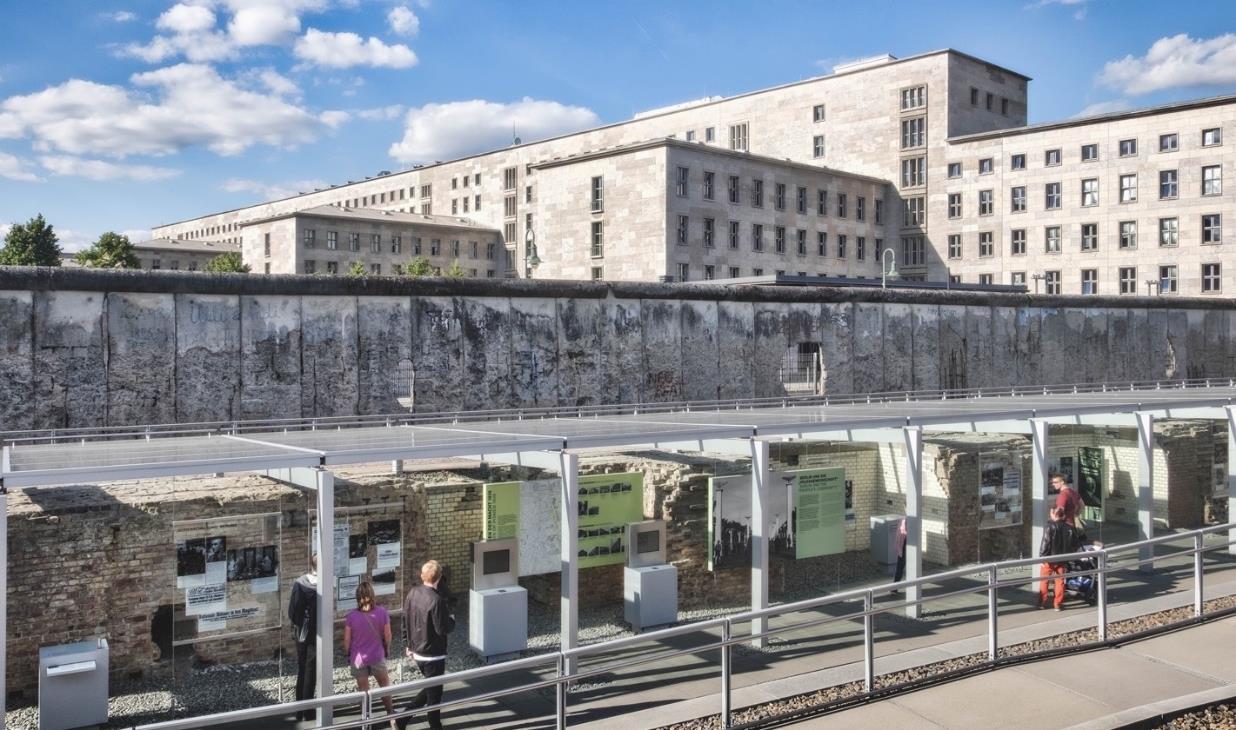
10
© www.travual.com // Buy the complete guide on shop.themediabay.be/en
7 H
Topographie des Terrors and the Nazi Ministry of Aviation – © Marie-Lise Van Wassenhove
Before World War II, Potsdamer Platz was heavily associated with modern technology. Because it was such a crowded traffic junction, the first traffic lights were installed here. However, after the war there was nothing left of that former glory. Furthermore, the square was located in the neutral zone and remained a wasteland until the reunification.
After the fall of the Berlin Wall, plans were made to once again make it the entertainment district of the city. New developments were started, the Sony Center being the most famous. Under its giant dome, there is a big cinema complex and many cafés and restaurants. A double row of cobblestones in the road marks were the Wall used to be.
Every September, the annual Berlin International Film Festival takes place here, making it the ideal time to spot some celebrities.
Continue walking along the Potsdamer Straße. Cross the busy Ben-Gurion-Straße, and walk into the first street on your right (Sharounstraße). You are now in the Kulturforum, with the Musikinstrumentenmuseum (Musical Instrument Museum) on your right and the Kunstgewerbemuseum on your left
Near Tiergarten and Potsdamer Platz lies the famous Kulturforum, a collection of modern buildings that houses a great variety of cultural museums. The architecture alone is worth a look.
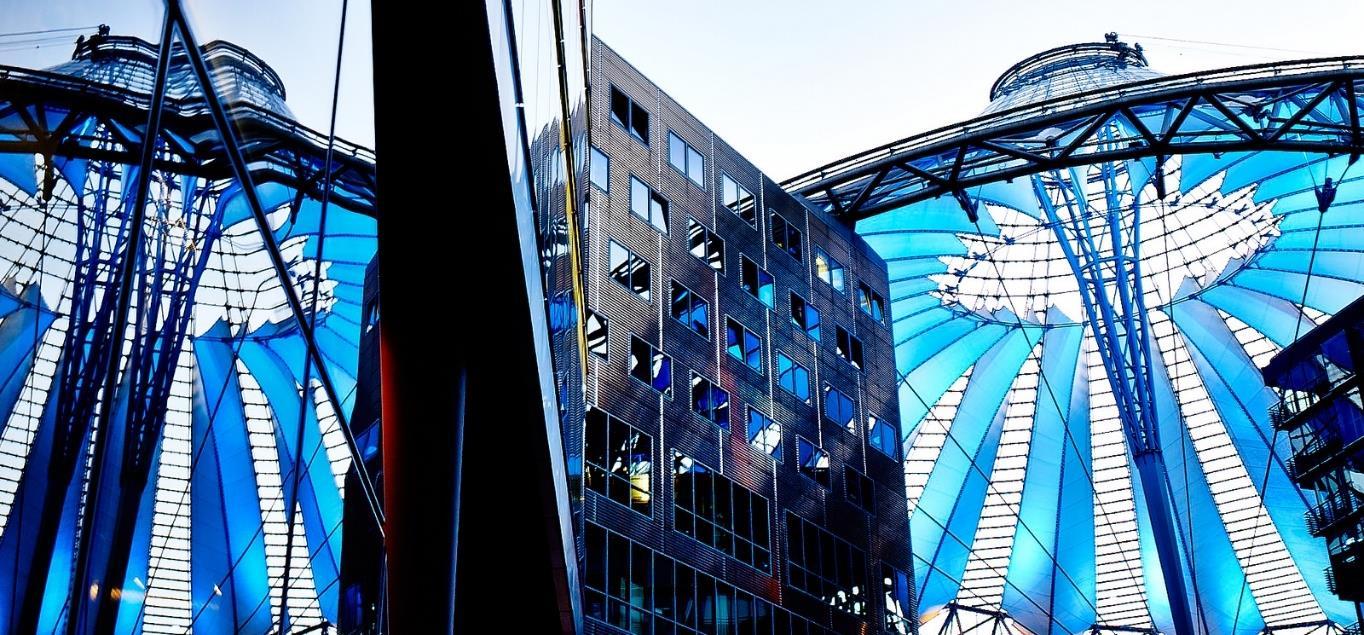
The most important museum is the Gemäldegalerie. It contains an enormous collection of paintings (about 25,000) from between the 13th 18th centuries with works by, among others, Rembrandt, Vermeer, Rubens and Goya. Modern art can be found in the Neue Nationalgalerie.
The Concert Hall of the Berliner Philharmoniker is also located in the Kulturforum.

© www.travual.com // Buy the complete guide on shop.themediabay.be/en 11
Reflections – Potsdamer Platz – © Mini Malist
8 I J
Take a right when you arrive on the Tiergartenstraße, and continue until you reach the Ebertstraße. On your left, you’ll see the Memorial to the Murdered Jews of Europe. Before going there, we make a short stop at another historically important place. Cross the Ebertstraße and walk into the street immediately on the left (In den Ministergärten). Walk to the end. You’ll reach a very common looking parking lot. This is the place where Hitler’s bunker used to be.
During the last months of the war, Hitler commanded his troops from this very bunker When it became clear the Nazis had lost the War, he committed suicide here on 30 April 1945, together with his companion, Eva Braun. To prevent the spot from becoming a pilgrimage destination, the bunker was completely dismantled over the course of several attempts. The only thing left that indicates the history of this place is an information sign with a map of the bunker.
A stone’s throw from the hidden and removed Führerbunker, you can find the big Memorial to the Murdered Jews of Europe. Take the Gertrud-Kolmar-Straße to the north to reach this impressive monument.
In May 2005, the Memorial to the Murdered Jews of Europe was opened. It consists of 2,751 blocks of various sizes, unequally distributed over a wavy surface of 19,000 square metres. While walking through it, you may experience an anxious, disoriented feeling. Connected to this memorial is an underground information centre that provides more info about the Holocaust. Access is free, but the lines can be very long!
When you walk through the memorial, you will reach the Behrenstraße. Go to the left, so you enter the Ebertstraße again. Keep following the Ebertstraße in the direction of the Brandenburger Tor. Behind the Brandenburger Tor, on the left, lies the Reichstag.
The Brandenburger Tor is the ultimate symbol of Germany’s and Berlin’s reunification. This gate, built in the 18th century, is the only remaining city gate of 18. It was heavily damaged during World War II and restored afterwards. However, after the Wall’s construction the gate was closed until 22 December 1989. The national symbol received yet another restoration and shines again in all its former glory, even though both time and the city’s history have left a considerable mark on it.

© www.travual.com // Buy the complete guide on shop.themediabay.be/en 12
9 K L M
In 1894, the Reichstag was inaugurated as the parliamentary building of the German Empire. Since then, it has always had a great symbolic value for the German people. In 1933, the large meeting room was destroyed by arson. Hitler used this incident to seize complete power, citing it as a threat towards the German people. At the end of World War II, the Soviet soldiers placed their flag on the Reichstag, a sign of Germany’s defeat. After the War, the Reichstag was almost completely destroyed, and since Berlin was no longer a capital city, it was no longer in use. It wasn’t until after the reunification and the impending move of the seat of government that the significant restoration works began. The British architect Norman Robert Foster placed a glass dome on it, which you can visit. The Reichstag is once again the parliamentary building of the Bundestag (German parliament). Countless visitors come here to admire the building’s beautiful architecture, among other things.
Some practical information if you want to visit the dome: generally speaking, the number of people who want to visit the dome exceeds its capacity. Therefore, you must register using an online form at least four days and at most two months in advance. However, if it is not too busy and you’re in luck, you might get tickets a few hours beforehand.
Platz der Republik 1, Berlin // https://www.bundestag.de/besucher

On the river bank, take a right towards the Reichstagufer and walk until the Friedrichstraße, where you can also find a train station (regional trains, U-Bahn and S-Bahn).

© www.travual.com // Buy the complete guide on shop.themediabay.be/en 13
10 0 N
Brandenburger Tor – © Marie-Lise Van Wassenhove



© www.travual.com // Buy the complete guide on shop.themediabay.be/en 14 End of the walking tour at the Friedrichstraße U-Bahn 11 0 Looking for a place to stay in Berlin? Check out these special offers!


© www.travual.com // Buy the complete guide on shop.themediabay.be/en 15 HIGHLIGHTS
OF BERLIN - OVERVIEW

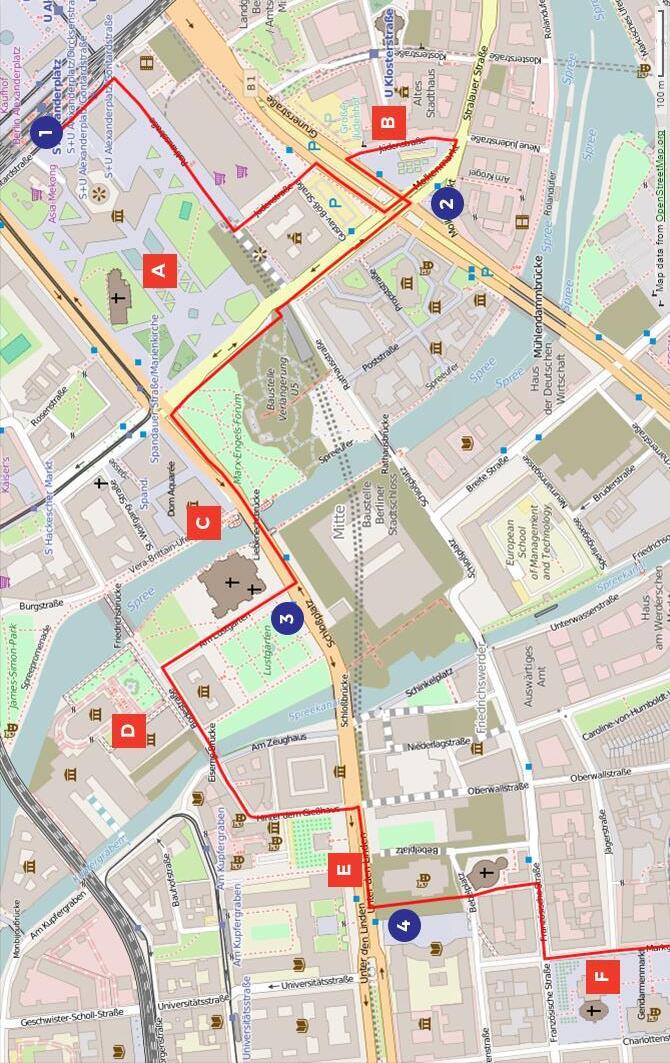
© www.travual.com // Buy the complete guide on shop.themediabay.be/en 16 HIGHLIGHTS OF BERLIN
– PART 1


© www.travual.com // Buy the complete guide on shop.themediabay.be/en 17 HIGHLIGHTS OF BERLIN –
PART 2

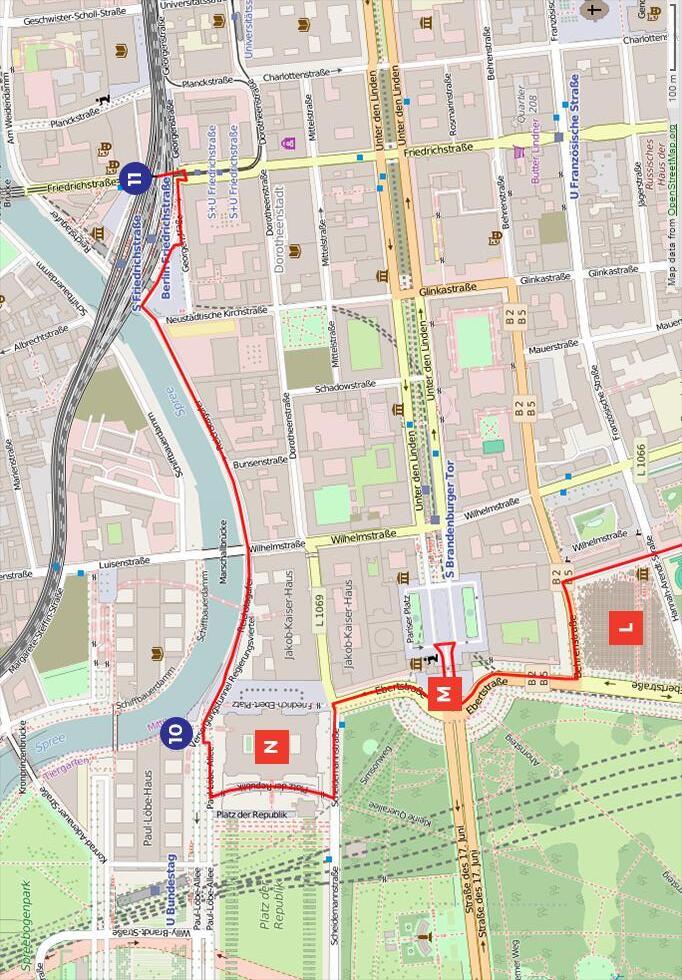
© www.travual.com // Buy the complete guide on shop.themediabay.be/en 18 HIGHLIGHTS OF BERLIN – PART
3


© www.travual.com // Buy the complete guide on shop.themediabay.be/en 19


© www.travual.com // Buy the complete guide on shop.themediabay.be/en 20
This free travel guide contains the first of our waking tours of Berlin. Curious for more Berlin? Buy the complete travel guide (pdf – 81 pages A4, easy to print or read on tablet) for the price of 4 cups of coffee, and explore the city with 4 extra walking tours, lots of practical information and hidden gems
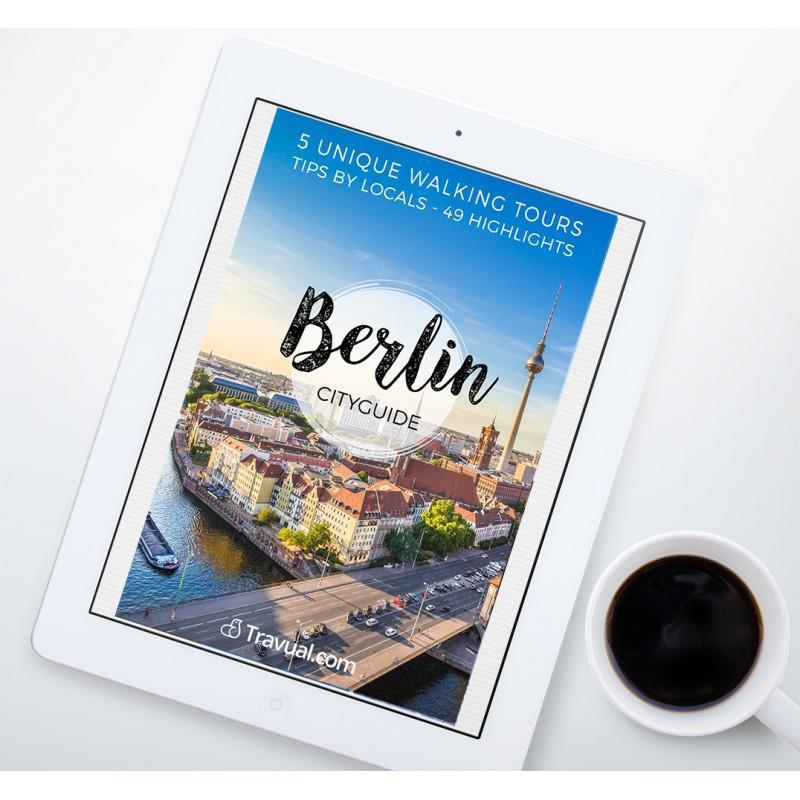

Disclaimer
We get our information from reliable and carefully selected sources. Even so, we can’t be held responsible for any possible inaccurate information, nor for the use of this information and any possible negative consequences.
We would highly appreciate it if you would pass on any remarks, additions or inaccuracies to us via info@themediabay.be
Discover more travel guides at www.travual.com
Advertise in this guide?
Contact The Media Bay via info@themediabay.be

Latest update: December 2016
© All rights reserved.
This travel guide is a publication by The Media Bay.
Nothing from this publication may be reproduced without explicit consent from the publisher.
©
// Buy the
on
21
www.travual.com
complete guide
shop.themediabay.be/en
Buy now on shop.themediabay.be/en


















